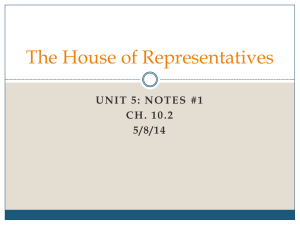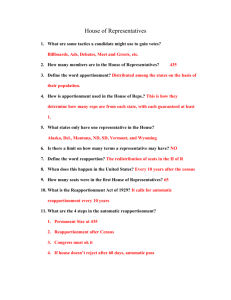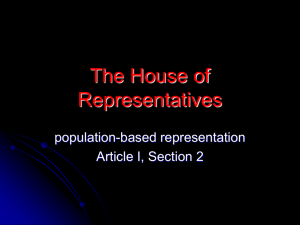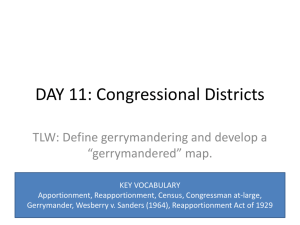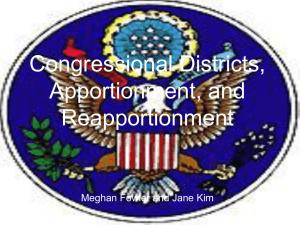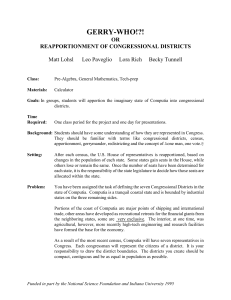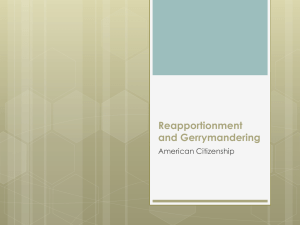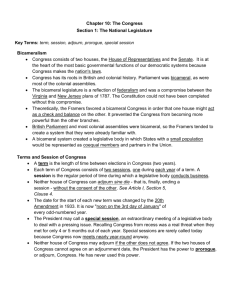Ch 10-2 The House of Representatives
advertisement
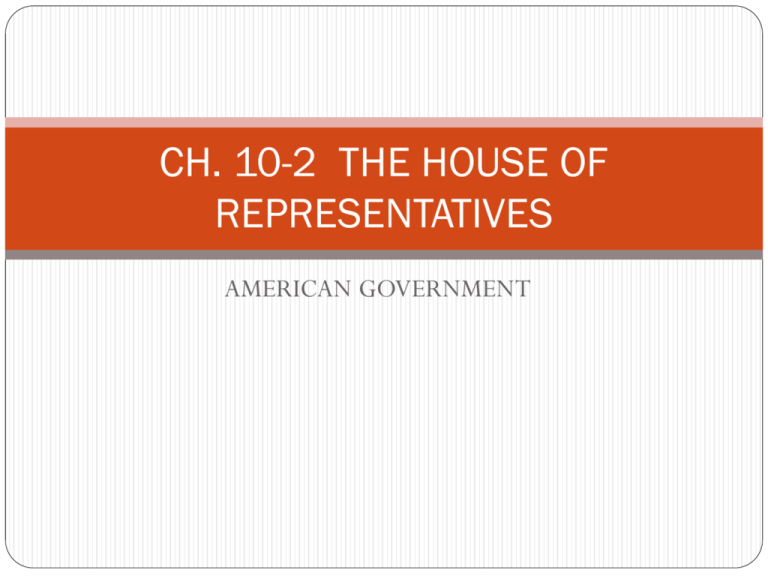
CH. 10-2 THE HOUSE OF REPRESENTATIVES AMERICAN GOVERNMENT SIZE AND TERMS 435 Representatives—set by Congress Each state has at least 1 representative based on population Only 1 representative – AK, DE, MT, ND, SD, VT, WY DC, Guam, Virgin Islands, American Samoa elect a delegate to represent them in the house (not full members) Article I, Section 2, Clause 1—”Representatives shall be…chosen every second Year…” Short term means that representatives need to pay close attention to “the folks back home” No term limits REAPPORTIONMENT Article I directs Congress to REAPPORTION (redistribute) the seats in the house after each DECENNIAL (10 years) census Original House had 65 members A GROWING NATION 1800—146 seats; 1810—186 seats 1910—AZ & NM added—435 seats 1920—No reapportionment completed (violated constitution) THE REAPPORTIONMENT ACT OF 1929 Set up “automatic reapportionment” 1) set up “permanent” size of the House at 435 each seat represents approx. 650,000 2) Census Bureau determines plan for number of representatives for each state after census 3) President sends plan sent to Congress for approval 4) If plan not rejected by either house within 60 days, it becomes effective CONGRESSIONAL ELECTIONS DATE Congressional elections are held on the same day in every state 1872—Election held on the first Tuesday after the first Monday 1872—Written or printed ballots used 1899—Voting machines approved OFF-YEAR ELECTIONS Elections that occur in years without a presidential election Usually the party in power (party that holds the presidency) loses seats during off-year elections (chart p. 269—Gains and Losses in Off-year elections) DISTRICTS SINGLE-MEMBER DISTRICT—voters in each district elect 1 person to be the representative for that district AT-LARGE—all representatives are elected from the state without districts 1842—At-Large elections were outlawed by Congress 1872—Districts required to have “as nearly as practicable an equal number of inhabitants” 1901—All districts needed to be of “compact territory” (small geographic area) GERRYMANDERING Districts are drawn to the advantage of the political party that controls the State’s legislature Gerrymandering is wide-spread today at all levels of government Two reasons: 1) to concentrate the opposition’s voters in one or a few districts, thus leaving other districts comfortably safe 2) to spread the opposition as thinly as possible among several districts, limiting the opposition’s ability to win anywhere in the region. Congressional districts varied widely with regard to population WESBERRY v. SANDERS (1964) Supreme Court ruled that the Constitution demanded that the States draw congressional districts of substantially equal populations “One person, one vote” Gerrymandering according to race is a violation of the XVth Amendment QUALIFICATIONS FOR HOUSE MEMBERS FORMAL QUALIFICATIONS 1) at least 25 years of age 2) citizen of the USA for at least 7 years 3) live in the state you are elected from Custom says you must live in the district you are representing The House decides about any challenge to an election The House can refuse to seat a member by majority vote The House can “punish its Members for disorderly behavior” by majority vote The House can expel a member by 2/3 vote INFORMAL QUALIFICATIONS Have to do with the candidate’s vote-getting abilities: 1) Party identification 2) Name familiarity 3) Gender 4) Ethnic characteristics 5) Political experience The right combination of these factors can help a candidate win nomination and election. The “wrong” combination will almost certainly spell defeat The End

